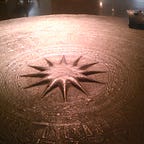Andrew Halyburton’s Ledger (December 1495)
Andrew Halyburton (aka Haliburton) was a Scottish merchant who lived and worked in Middelburg (which he knew as Medylburgh) in what is now the province of Zeeland in the Netherlands during the 1490s. He left a bare and apparently scratchily written ledger recording his activities, an edition of which was published by the Scottish historian Cosmo Innes in 1867. This ledger is in a kind of macaronic Middle Scots, including a fair few words in Middle Dutch and other languages — a testament to the multiculturalism of the world in which Halyburton moved. He was involved in all sorts of trading activities, including the traffic in spices and perfumes, so it is perhaps unsurprising to see purchases of Indonesian spices recorded in the ledger.
I’ve put an extract from Innes’s edition of Halyburton’s ledger below. The items logged therein were purchased in December 1495 at Bergen op Zoom (known to Halyburton as Bery — Figure 1) in North Brabant, and appear on folio 23r of the ledger (Innes 1867:22). Several Indonesian spices are included, as are a number of others (cinnamon, ginger, pepper) that could have come from the Indo-Malaysian archipelago but could just as easily have been grown in India or elsewhere.
TEXT
[…] Item 3 dossin pepar, cost 19 gꝬ. the l͠i.
Item 2 dossyn gyingar, cost 17 gꝬ. the l͠i. Item 2 l͠i.
canell, cost 4 ͠s. 8 gꝬ. l͠i.; 2 l͠i masses, cost 3 ͠s. 10 gꝬ. the l͠i.;
1 l͠i. clois, cost 3 ͠s.; 1 l͠i. galyga, cost 5 ͠s. 4 gꝬ.; a l͠i.
swenvel, cost 3 ͠s.; 2 l͠i. notmogis, cost 2 ͠s. 2 gꝬ.; 2 l͠i.
saferon, cost 10 ͠s. […]
TRANSLATION
‘Item, three dozens of pepper, cost 19 groats a pound. Item, two dozens of ginger, cost 17 groats a pound. Item, two pounds of cinnamon, cost four shillings and eight groats a pound; two pounds of mace, cost three shillings and ten groats a pound; one pound of cloves, cost three shillings; one pound of galangal, cost five shillings and four groats; a pound of zedoary (1), cost three shillings; two pounds of nutmeg, cost two shillings and two groats; two pounds of saffron, cost ten shillings…’
NOTES
(1) The word here is transcribed by Innes as <swenvel>, but it could well be an error. I haven’t seen the original text. The word swenvel does not appear in the Dictionary of the Scots Language and I’m not aware of any similar terms in other European languages of the day (although let me know if you are aware of such things!). The term is most reminiscent of words in other medieval European texts for ‘zedoary’ (Indonesian: temu putih, aka Curcuma zedoaria), a plant in the ginger family (Zingiberaceae).
The value of the ledger lies in part in its detail on prices. As Halyburton was based at Middelburg it may be presumed that the money here is in Flemish pounds, shillings (stuivers), and groats (groten) (‘the common currency of the Netherlands’, as the editor put it [Innes 1867:xxvi]) rather than their Scottish equivalents. These spices were somewhat expensive but they certainly weren’t worth their weight in gold: In another entry, Halyburton purchased half a pound of gold for £1 and 4 shillings. A pound of cloves (clois), by comparison, could be had for three shillings — and if you know anything about cloves then you’ll know that a pound (~450g) is a heck of a lot of cloves. The idea that these spices were incredibly expensive and luxurious seems to be a gross misconception.
1495 is later than most of the other things I’ve looked at on this blog and to many people Halyburton’s ledger would be considered a post-medieval/early modern document. Columbus had visited the Caribbean twice by this point. In England a Tudor king, Henry VII, had been on the throne for ten years; his victory at the battle of Bosworth is generally considered to represent the end of the Middle Ages over there. However, cloves and nutmeg (etc.) still came to Europe the same way they had for centuries and until 1509 there were no direct links between Europe and island Southeast Asia. This shows, I think, just how pointless it is to draw a hard boundary between the Middle Ages and early modernity and why periodisation should probably be based more on the nature of interactions than on arbitrary dates or singular events.
Innes, Cosmo (ed). 1867. Ledger of Andrew Halyburton. Edinburgh: Her Majesty’s General Register House.
Thanks go to Ian Burdon (@Cosmic_Serf) for alerting me to the existence of a searchable Scots dictionary complete with citations. The dictionary pointed me in the direction of Halyburton and Innes’s edition — see https://dsl.ac.uk/, which is wonderful and works in a similar way to the diachronic Dutch dictionary on the Instituut voor de Nederlandse Taal site ( https://ivdnt.org/).
I have a Ko-Fi account, in case you’re interested in showing your appreciation for this and other Medium stories: https://ko-fi.com/P5P6HTBI
A. J. West, December 2019
